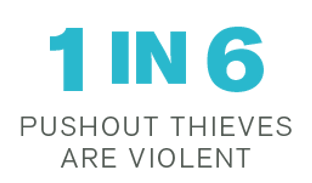Shoplifting is on the rise, according to the latest statistics. The question of how much money is lost to external theft in the retail industry is a tricky one, as is the question of how to stop it, with recommendations ranging from redesigning your store layout to investing in asset tracking.
Here, we’ve rounded up the most relevant shoplifting statistics for businesses, along with the context we felt helped explain the importance of each data point. Specifically, we tackle stocks, legislation, loss prevention budgets, and explore the role AI could play preventing shoplifting in the future.
This guide also features a list of top tips to help you keep your products safe from shoplifters, so read on and arm yourself with the knowledge necessary to fight back against petty criminals.
Key Shoplifting Statistics
- Stores lost an estimated $86.6 billion to retail theft in 2022. Predictions by CapitalOne suggest this amount could reach $115 billion in 2025. (CapitalOne)
- Total retail sales have risen fast in recent years: They were around $6.2 trillion in 2019 but jumped to $7.4 trillion in 2021 and $8.1 trillion in 2022. (Census Bureau)
- In total, thirty-two states have passed legislation addressing organized retail crime. (U.S. Chamber of Commerce)
- 58% of retailers say their security personnel are allowed to “confront and detain” store shoplifters. (National Retail Security Survey 2023)
- Close to half (44.5%) of retailers say that their loss prevention budgets were increased in 2022. (National Retail Security Survey 2022)
How Common Is Shoplifting?
Stores lost about $86.6 billion to retail theft in 2022, but that includes employee theft as well as external theft. Still, it’s fair to say that shoplifting accounts for billions lost across the industry every year, and could be as high as 1.4% to 1.8% of total annual retail sales, depending on inflation levels, total inventory size, and other factors.
Shoplifting statistics can be misleading, because so many terms are unclear. Take the idea of “retail shrink”: This industry term refers to all inventory losses, which is as likely to include any damage, administrative errors, or neglience as it is to include theft.
Shoplifting Statistics for Small Businesses in 2024
Here are the key data points to know about theft, crime data collection, retail shrink, store closures, and everything else related to shoplifting in 2024.
1. Retail shrink losses
- Retail shrink accounted for an estimated $112.1 billion in 2022 losses, which is 1.6% of total retail sales across that year. (National Retail Security Survey 2023)
- This statistic shows the scale of loss that is accompanied by shoplifting. The number is nothing if not substantial, and curbing theft can clearly has a significant impact on funds available for other services.
2. Increasing aggression
- The 2022 Retail Security Survey found that 8 out of 10 retailers self-reported increased incidents of “violence and aggression” across 2022. (National Retail Security Survey 2022)
- This statistic demonstrates the danger of shoplifting, for perpetrators and victims in real time, as the physicality factor can turn simple theft into outright assault.
3. The growth of retail shrink
- Losses due to retail shrink reached an estimated $94.5 billion in 2021, up from 2020’s $90.8 billion. That’s 1.4% of total retail sales in 2021. (National Retail Security Survey 2022)
- This statistic shows that retail theft is on the rise, a troubling but understandable fact, given the increasing price of goods and the stagnation of wages over the last few decades.
4. 15% of stores see 3% retail shrink
- 15.7% of stores in one study reported “3% and higher” amounts of retail shrink across fiscal year 2020, up from just 9% of stores in 2016. (National Retail Security Survey 2021)
- This statistic highlights the widespread increase in shoplifting across the US, with huge spikes increasing over the years.
5. Just 37% of retail shrink is external theft
- An estimated 37% of all retail shrink is due to external theft, while internal theft and mistakes together account for 54% of shrink. (National Retail Security Survey 2021)
- This statistic is a friendly reminder that shoplifting is far from the only problem that retail stores are facing, despite its use across the media to highlight an alleged growing crime problem.
6. Organized retail crime rates
- For each retail company, the average organized retail crime costs 7 cents for every $100 earned in sales. (National Retail Security Survey 2022)
- This statistic demonstrates that shoplifting accounts for a comparably small percentage of loss, but it can still have an impact on business as a whole.
7. Total retail sales rising
- Total retail sales have risen fast in recent years: They were around $6.2 trillion in 2019, before jumping to $7.4 trillion in 2021 and $8.1 trillion in 2022. (Census Bureau)
- This statistic may in part explain the rise of retail shrink, given that more and more people are making purchases, affecting the impacts of shoplifting on everyday businesses.
8. Unreliable crime data?
- 40% of law enforcement agencies failed to report their most recent crime data to the FBI (The Marshall Project)
- This statistic demonstrates that some statistics related to retail crime are likely to have incomplete or out of date information, so it’s hard to pinpoint the exact problem.
9. Chain stores report the most thefts
- Chain stores reported nearly double the number of theft complaints across 2022 in New York City as non-chain drug stores or department stores, reporting a total of 24,594 complaints, compared to 13,046 from drug stores or 13,058 from department stores. (NYC Criminal Justice)
- This statistic demonstrates that small, independent businesses are not nearly as at risk as big chain stores when it comes to theft. Given their considerable resources, these chains are likely more equipped to deal with the fallout.
10. Legal penalties
- Nine states have imposed harsher punishments for organized retail crime offenses since 2022. (CNBC)
- This statistic shows that organized retail crime is a much bigger problem than everyday people shoplifting, and states are in turn focusing on penalizing that more to solve the issue.
11. Retail theft crackdown states
- In 2022, legislators in California, Florida, Louisiana, and North Carolina stiffened penalties for stealing from stores. (The Marshall Project)
- This state shows that penalties are increasing where shoplifting is most prevalent, with California and Florida both featuring cities on the top 10 list of most impacted by retail theft.
12. 32 states have retail crime laws
- In total, 32 states have passed legislation addressing organized retail crime. (U.S. Chamber of Commerce)
- This statistic outlines that the majority of states across the US are taking action to curb shoplifting, and more are likely on the way soon.
13. Store closures not due to shoplifting
- Target cited rising thefts and organized retail crime for the recent closure of nine stores out of its around 1,950 US locations.
- This statistic is misleading, as publicly available crime data for stores closed in New York and San Francisco had lower crime rates than other locations that remained open. (Popular Information)
14. Banks fear organized retail crime the most
- Banks were most likely to name organized retail crime in their 10-Ks between 2011 and 2022, followed in order by Capital Markets, Consumer Finance, Insurance, and IT Services. (U.S. Chamber of Commerce)
- This statistic shows that financial organizations are leading the charge against organized retail crime, as they likely have the most to lose in the long run.
15. Voters can’t agree on shoplift intervention
- A 2023 NewsNation poll found that 44.97% of US voters think retail employees should not be expected to intervene to stop shoplifters, while 39.03% believe they should be and 16% have no opinion. (NewsNation)
- This statistic highlights that most Americans don’t believe that retail workers should be forced to put their lives on the line to save big chains from losing .07% of their revenue.
16. Retailers allowing shoplifter intervention
- 58% of retailers say their security personnel are allowed to “confront and detain” store shoplifters. (National Retail Security Survey 2023)
- Despite voters believing otherwise, retailers are hiring security professionals to combat the growing shoplifting problem by allowing them to actively challenge shoplifters in the act at locations.
17. Retail salespeople have the worst job in the US
- Being a retail salesperson was ranked as the worst job in the entire U.S. economy out of a total of 190 jobs. (U.S. News and World Report)
- This statistic shows that, in addition to dealing with shoplifters, retail workers are unhappy about low wages and limited career growth chances in their role.
18. Retail stocks remain high
- The S&P Retail Select Industry Index more than doubled between March 2020 and December 2022. (Bloomberg)
- This statistic shows that the rise in shoplifting is having little to no impact on the success of retail businesses, with high prices and increased sales spurring record highs across the industry.
19. Loss prevention slightly rises
- Close to half (44.5%) of retailers say that their loss prevention budgets were increased in 2022: The largest amount, 28.6%, reported increases of between 1% to 9.9%. That said, the largest single amount, 47.6%, said their budgets were remaining the same as in 2021. (National Retail Security Survey 2022)
- This statistic shows that retailers are making a big push to combat shoplifting in their stores, investing more than they are losing in an attempt to curb the problem.
20. RFID tracking remains low
- Just 17% of retailers are testing or piloting RFID tracking to combat shoplifting. (National Retail Security Survey 2023)
- This statistic highlights the potential for retailers to combat the shoplifting problem in a meaningful way, and the confusing lack of initiative when it comes to using these tactics instead of hiring security personnel.
21. RFID research is ongoing
- 39% of retailers say they are researching and/or testing RFID for identification tagging. In addition, 31% are either researching, testing or implementing RFID for “benefit denial capabilities.” (National Retail Security Survey 2023)
- This statistic demonstrates that retailers are finally beginning to explore the possibility of branching out and finding new ways to combat shoplifting at their stores.
22. Top cities for shoplifting
- Los Angeles, San Francisco/Oakland, and Houston are the cities most affected by organized retail crime. (National Retail Federation)
- This statistic demonstrates that there is no political basis behind shoplifting, but that it is a national problem that occurs across the spectrum.
23. Lost sales tax to shoplifting by state
- Mississippi is the state that loses the most sales tax to retail theft, at $24 per capita. (National Retail Federation)
- This statistic shows that states impacted by shoplifting struggle in other areas as well, with Mississippi being one of the poorest states across all of the US.
24. Lost potential revenue to retail theft by state
- Hawaii loses the most potential revenue per capita, at $2,303.80. (National Retail Federation)
- This statistic is largely impacted by the cost of living, as Hawaii is considered one of the most expensive states to live, with many products costing extra due to the shipping costs from other states.
25. Felony threshold for theft by state
- The average felony threshold for shoplifting in states across the US is $1,180. (National Retail Federation)
- This statistic shows that there is a limit to how much someone can shoplift before it becomes a serious problem from a law enforcement standpoint.
What Is the Most Shoplifted Item?
It’s impossible to determine the single most shoplifted item around the world, given the disparate studies and analysis from franchise to franchise and country to country. However, one of the most frequently shoplifted items is baby formula — most likely because it is expensive, crucial for new parents, and small enough to conceal easily. Alcohol is another popular item among shoplifters, as is laundry detergent.
Shoplifting Prevention Advice for Small Businesses
Store managers and loss prevention specialists can take some steps to prepare for shoplifting, from creating a standard protocol to basic scenario training. You’ll also want to rethink your store layout: Placing cash registers closer to the exit can help employees respond faster, while moving high-value products to high-visibility areas can make a potential shoplifter think twice.
Hardware tools can give workers an extra advantage. Security cameras are the biggest help, but entrance alert systems and friendly warning signage will also work to reduce shoplifting.
An asset tracking system can help: These make sure you can find all your equipment, phones, and office paperwork, and many of them offer the inventory-tracking functions to help you keep an eye on products as well. You can choose from one of the best asset tracking companies if you need help getting started, or opt to use free asset tracking software instead.
Finally, there’s one last option worth considering: AI.
The Role of AI in Shoplifting Prevention
Artificial intelligence is evolving in leaps and bounds, with shoplifting prevention just one of many potential applications. Some software developers have created AI that scans CCTV security camera footage in real time, looking for movements from customers that could indicate shoplifting.
What’s more, some stores have already starting using these programs – One San Jose grocery st+-ore had already been using shoplifting prevention AI for six months in one May 2022 article covering a software that was itself operating in more than 1,000 hardware, liquor, and groceries stores around the world.
While this software can be a time-saver, since it scans video footage and alerts a store manager with a mobile notification, it’s far from perfect. We recommend ensuring that a human makes the final call on a shoplifting attempt, even if an AI flags it first.
Source: Tech.co



